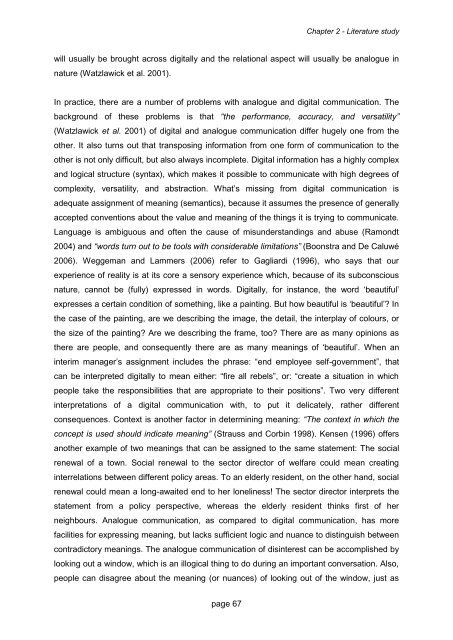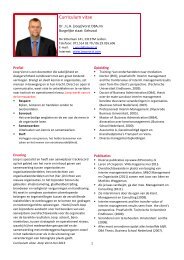Hoofdstuk 1 - Joop Vorst
Hoofdstuk 1 - Joop Vorst
Hoofdstuk 1 - Joop Vorst
Create successful ePaper yourself
Turn your PDF publications into a flip-book with our unique Google optimized e-Paper software.
page 67<br />
Chapter 2 - Literature study<br />
will usually be brought across digitally and the relational aspect will usually be analogue in<br />
nature (Watzlawick et al. 2001).<br />
In practice, there are a number of problems with analogue and digital communication. The<br />
background of these problems is that “the performance, accuracy, and versatility”<br />
(Watzlawick et al. 2001) of digital and analogue communication differ hugely one from the<br />
other. It also turns out that transposing information from one form of communication to the<br />
other is not only difficult, but also always incomplete. Digital information has a highly complex<br />
and logical structure (syntax), which makes it possible to communicate with high degrees of<br />
complexity, versatility, and abstraction. What‟s missing from digital communication is<br />
adequate assignment of meaning (semantics), because it assumes the presence of generally<br />
accepted conventions about the value and meaning of the things it is trying to communicate.<br />
Language is ambiguous and often the cause of misunderstandings and abuse (Ramondt<br />
2004) and “words turn out to be tools with considerable limitations” (Boonstra and De Caluwé<br />
2006). Weggeman and Lammers (2006) refer to Gagliardi (1996), who says that our<br />
experience of reality is at its core a sensory experience which, because of its subconscious<br />
nature, cannot be (fully) expressed in words. Digitally, for instance, the word „beautiful‟<br />
expresses a certain condition of something, like a painting. But how beautiful is „beautiful‟? In<br />
the case of the painting, are we describing the image, the detail, the interplay of colours, or<br />
the size of the painting? Are we describing the frame, too? There are as many opinions as<br />
there are people, and consequently there are as many meanings of „beautiful‟. When an<br />
interim manager‟s assignment includes the phrase: “end employee self-government”, that<br />
can be interpreted digitally to mean either: “fire all rebels”, or: “create a situation in which<br />
people take the responsibilities that are appropriate to their positions”. Two very different<br />
interpretations of a digital communication with, to put it delicately, rather different<br />
consequences. Context is another factor in determining meaning: “The context in which the<br />
concept is used should indicate meaning” (Strauss and Corbin 1998). Kensen (1996) offers<br />
another example of two meanings that can be assigned to the same statement: The social<br />
renewal of a town. Social renewal to the sector director of welfare could mean creating<br />
interrelations between different policy areas. To an elderly resident, on the other hand, social<br />
renewal could mean a long-awaited end to her loneliness! The sector director interprets the<br />
statement from a policy perspective, whereas the elderly resident thinks first of her<br />
neighbours. Analogue communication, as compared to digital communication, has more<br />
facilities for expressing meaning, but lacks sufficient logic and nuance to distinguish between<br />
contradictory meanings. The analogue communication of disinterest can be accomplished by<br />
looking out a window, which is an illogical thing to do during an important conversation. Also,<br />
people can disagree about the meaning (or nuances) of looking out of the window, just as



